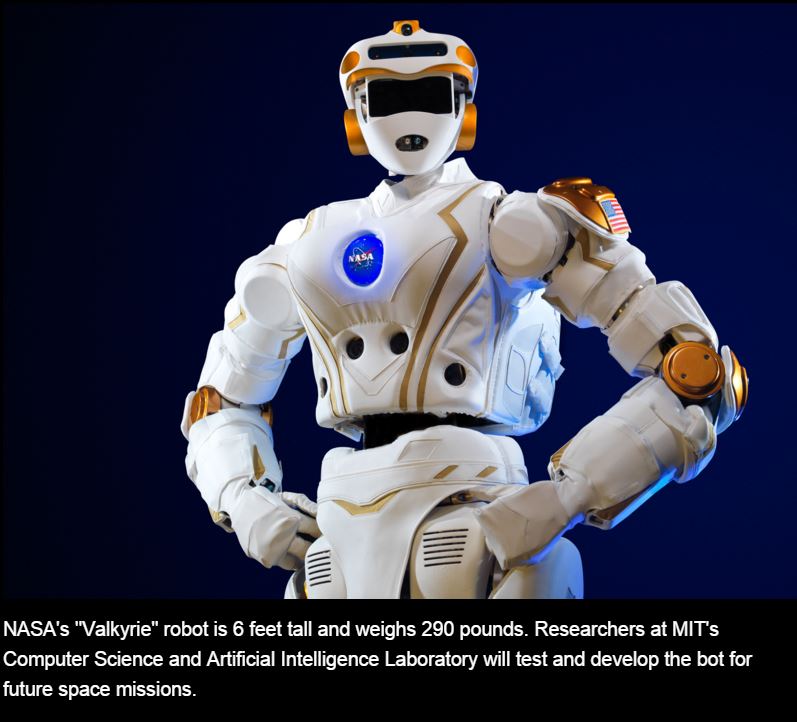Could we send humanoid robots into space?
Stay up to date:
Space
This article is published in collaboration with MIT News.
NASA announced that MIT’s Computer Science and Artificial Intelligence Laboratory(CSAIL) is one of two university research groups nationwide that will receive a 6-foot, 290-pound humanoid robot to test and develop for future space missions to Mars and beyond.
A group led by CSAIL principal investigator Russ Tedrake will develop algorithms for the robot, known as “Valkyrie” or “R5,” as part of NASA’s upcoming Space Robotics Challenge, which aims to create more dexterous autonomous robots that can help or even take the place of humans “extreme space” missions. (NASA’s challenge is divided into a virtual competition using robotic simulations, and a physical competition using the robot.)
Tedrake’s team, which was selected from groups that were entered in this year’s Defense Advanced Research Projects Agency (DARPA) Robotics Challenge, will receive as much as $250,000 a year for two years from NASA’s Space Technology Mission Directive.
Exploring deep space by bot
NASA says it is interested in humanoid robots because they can help or even replace astronauts working in extreme space environments. Robots like R5 could be used in future missions either as precursor robots performing mission tasks before humans arrive or as human-assistive robots collaborating with the human crew. While R5 was initially designed to complete disaster-relief maneuvers, its main goal is now to prove itself worthy of even trickier terrain: deep-space exploration.
“Advances in robotics, including human-robotic collaboration, are critical to developing the capabilities required for our journey to Mars,” said Steve Jurczyk, associate administrator for the Space Technology Mission Directorate (STMD) at NASA Headquarters in Washington, in a NASA press release. “We are excited to engage these university research groups to help NASA with this next big step in robotics technology development.”
Autonomy for autos, robots and more
As head of CSAIL’s Robot Locomotion Group, Tedrake has extensive experience with autonomous robots. Over the past three years he led a team of more than 20 researchers to develop algorithms for a government competition to get another 6-foot-tall humanoid robot named Atlas to open doors, turn valves, drill holes, climb stairs, scramble over cinder blocks, and drive a car — all in the space of one hour.
Tedrake is also part of CSAIL’s new $25 million Toyota-funded research center for autonomous cars, specifically focused on advanced decision-making algorithms and systems that allow vehicles to perceive and navigate their surroundings safely, without human input. The larger collaboration will be coordinated by Gill Pratt PhD ’89, a former MIT professor who most recently served as program director at DARPA’s Defense Sciences Office.
In addition to Tedrake’s team at CSAIL, NASA also awarded a R5 robot to a team led by Taskin Padir at Northeastern University.
Publication does not imply endorsement of views by the World Economic Forum.
To keep up with the Agenda subscribe to our weekly newsletter.
Author: Adam Conner-Simons is a Communications Coordinator at Massachusetts Institute of Technology (MIT).
Image: The sun is about to come up over the South Pacific Ocean in this colorful scene photographed by one of the crew members aboard the Earth-orbiting International Space Station . NASA/Handout via Reuters.
Don't miss any update on this topic
Create a free account and access your personalized content collection with our latest publications and analyses.
License and Republishing
World Economic Forum articles may be republished in accordance with the Creative Commons Attribution-NonCommercial-NoDerivatives 4.0 International Public License, and in accordance with our Terms of Use.
The views expressed in this article are those of the author alone and not the World Economic Forum.
Related topics:
Forum Stories newsletter
Bringing you weekly curated insights and analysis on the global issues that matter.
More on Emerging TechnologiesSee all
Rya G. Kuewor
May 13, 2025
Tea Trumbic and Dhivya O’Connor
May 13, 2025
Anurag Sinha
May 9, 2025
Jake Okechukwu Effoduh
May 7, 2025
Ti Hwei How
May 7, 2025






